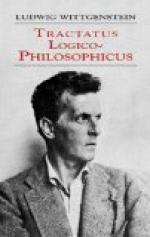4.44 The sign that results from correlating the mark ’I” with truth-possibilities is a propositional sign.
4.441 It is clear that a complex of the signs ‘F’ and ‘T’ has no object (or complex of objects) corresponding to it, just as there is none corresponding to the horizontal and vertical lines or to the brackets.— There are no ‘logical objects’. Of course the same applies to all signs that express what the schemata of ‘T’s’ and ‘F’s’ express.
4.442 For example, the following is a propositional sign: (Frege’s ‘judgement stroke’ ‘|-’ is logically quite meaningless: in the works of Frege (and Russell) it simply indicates that these authors hold the propositions marked with this sign to be true. Thus ‘|-’ is no more a component part of a proposition than is, for instance, the proposition’s number. It is quite impossible for a proposition to state that it itself is true.) If the order or the truth-possibilities in a scheme is fixed once and for all by a combinatory rule, then the last column by itself will be an expression of the truth-conditions. If we now write this column as a row, the propositional sign will become ‘(TT-T) (p,q)’ or more explicitly ‘(TTFT) (p,q)’ (The number of places in the left-hand pair of brackets is determined by the number of terms in the right-hand pair.)
4.45 For n elementary propositions there are Ln possible groups of truth-conditions. The groups of truth-conditions that are obtainable from the truth-possibilities of a given number of elementary propositions can be arranged in a series.
4.46 Among the possible groups of truth-conditions there are two extreme cases. In one of these cases the proposition is true for all the truth-possibilities of the elementary propositions. We say that the truth-conditions are tautological. In the second case the proposition is false for all the truth-possibilities: the truth-conditions are contradictory . In the first case we call the proposition a tautology; in the second, a contradiction.
4.461 Propositions show what they say; tautologies and contradictions show that they say nothing. A tautology has no truth-conditions, since it is unconditionally true: and a contradiction is true on no condition. Tautologies and contradictions lack sense. (Like a point from which two arrows go out in opposite directions to one another.) (For example, I know nothing about the weather when I know that it is either raining or not raining.)
4.46211 Tautologies and contradictions are not, however, nonsensical. They are part of the symbolism, much as ‘0’ is part of the symbolism of arithmetic.
4.462 Tautologies and contradictions are not pictures of reality. They do not represent any possible situations. For the former admit all possible situations, and latter none . In a tautology the conditions of agreement with the world—the representational relations—cancel one another, so that it does not stand in any representational relation to reality.




